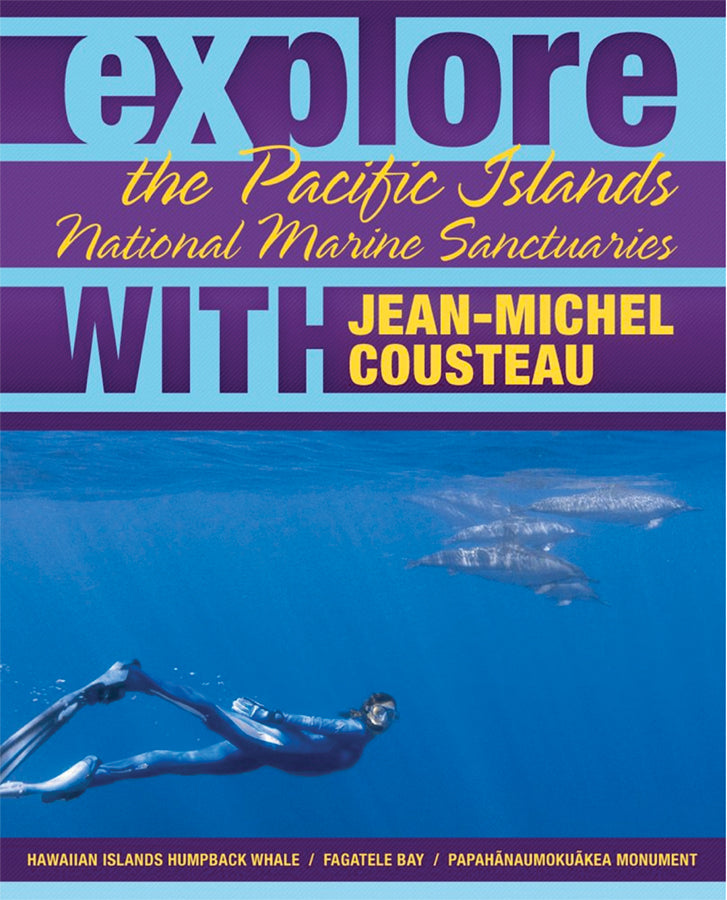Based on the famed French explorer’s film series, Jean-Michel Cousteau: Ocean Adventures, these are the definitive guides to America’s thirteen National Marine Sanctuaries and its one Marine National Monument. Each of the four books conducts a grand adventure through one of the four regions of the National Marine Sanctuary system, combining engaging descriptions, stunning four-color photography, and behind-the-scenes stories from the Ocean Futures Society expedition team. Insightful inquiries into the health of the world’s oceans are provided along with an overview of several incredible underwater treasures. Conveying the beauty of the ocean and the specific measures being put into effect to preserve it, this inspirational collection also features detailed, practical information for planning visits to the sanctuaries.
Jean-Michel Cousteau, the son of Jacques Cousteau, is the author of America's Underwater Treasures, the Explore the National Marine Sanctuaries series, and My Father, the Captain,and is a founder of the National Marine Sanctuary Foundation. He is a recipient of the Emmy Award, the Peabody Award, the 7 d’Or, and the Cable Ace Award. He has produced more than eighty films, and is the executive producer of the television show Jean-Michel Cousteau: Ocean Adventures. He lives in Santa Barbara, California.
Dr. Sylvia A. Earle, PhD, is an explorer-in-residence at the National Geographic Society, the leader of the Sustainable Seas Expeditions, and a chair of Google Earth advisory council for the ocean. She is a charter member of the Ocean Futures Society Advisory Board and the former chief scientist of the National Oceanic and Atmospheric Administration, as well as a founder of the National Marine Sanctuary Foundation. She lives in Oakland, California.
Maia McGuire, PhD, holds a PhD in Marine Biology and Fisheries. She is the Florida Sea Grant agent for the University of Florida and is the chair of the National Sea Grant Education Network. She has recently been named the Florida Wildlife Federation’s 2015 Conservation Educator of the Year.
Contents
Foreword by Dr.Sylvia Earle xii
Preface xiii
Introduction 1
About the Series 1
About National Sanctuaries 3
The National Marine Sanctuaries’ Pacific Island Region 5
Hawaiian Islands Humpback Whale National Marine Sanctuary 7
About the Hawaiian Islands Humpback Whale National
Marine Sanctuary 7
Why A National Sancturary? 10
Resources Within the Hawaiian Islands Humpback Whale
National Marine Sanctuary 15
Key Species Within the Sanctuary 21
Emerging Environmental Issues 31
Research Within the Sanctuary 39
Visiting the Sanctuary 40
National Marine Sanctuary of American Samoa 53
About the National Marine Sanctuary of American Samoa 53
Why A National Marine Sanctuary? 57
Resources Within National Marine Sanctuary of American Samoa 62
Key Species Within the Sanctuary 67
Emerging Environmental Issues 70
Research Within the Sanctuary 78
Visiting the Sanctuary 82
Papahānaumokuākea Marine National Monument 87
About Papahānaumokuākea Marine National Monument 87
Why A Marine National Sancturary? 95
Resources Within the Papahānaumokuākea Marine National
Monument 104
Key Species Within the Sanctuary 116
Emerging Environmental Issues 124
Research Within the Monument 130
Visiting the Monument 133
When You Visit the Sanctuaries 141
National Marine Sanctuary of American Samoa 150
Hawaiian Islands Humpback Whale National
Marine Sanctuary 15
Papahānaumokuākea Marine National Monument 158
Acknowledgments 163
Glossary 165
Biographies 169
Introduction
About the Series
The four book series, Explore the National Marine Sanctuaries with Jean-Michel Cousteau has been developed in partnership with the National Marine Sanctuary system and Ocean Future Society. Text in italics is excerpted from the previously, limited-edition book America’s Underwater Treasures by Jean-Michel Cousteau and Julie Robinson with photography by Carrie Vonderhatt. That book describes the experience and research of Jean-Michel Cousteau and his Ocean Futures Team while diving all 13 underwater marine sanctuaries and the one underwater marine monument. Their experiences is captured in a film by the same name aired on PBS as part of Jean-Michel Cousteau’s Ocean Adventures. The current series is offered to make information on these vital sanctuaries even more inclusive for the American public.
Each book in the series takes readers to one of the four regions of the country into which the National Oceanic and Atmospheric Administration (NOAA) has organized its management of the National Marine Sanctuaries. This book, Explore the Pacific Islands National Marine Sanctuaries with Jean-Michel Cousteau, visits sanctuaries and a national monument off Hawaii and American Samoa. The other books in the series are: Explore the Southeast National Marine Sanctuaries with Jean-Michel Cousteau, Explore the West Coast National Marine Sanctuaries with Jean-Michel Cousteau and Explore the Northeast National Marine Sanctuaries with Jean-Michel Cousteau.
The first National Marine Sanctuary in the United States was established only decades ago, while Yellowstone, the oldest of the American National Parks ,was created in 1872. By comparison the parks, these natural marine jewels were damaged upon arrival. Only small portions remain pristine. For many, their destinations arose amidst threats to one or a number of aspects to their survival. Like terrestrial parks, these are special habitats, managed zones for the recovery of critical species like humpback whales or juvenile rockfish but, most importantly, they attempt to preserve the integrity of the web of life.
Ironically, we discovered that managing these resources for sustainability was in truth an exercise in managing ourselves. And that’s not bad, as we’re still learning, an easy job. At each destination we were privileged witnesses to the real-time drama of marine conservation playing out across the United States. At the heart of it, we found a powerful paradigm shift happening in environmentalism. Fishermen, environmentalists and scientists from opposite sides of the aisle were sitting down together with rolled-up sleeves, poring through scientific research, debating the merits of reserves and restoration, and coming to terms with the new definition of sanctuary. “These are,” as Dan Basta, past director of the National Marine Sanctuary System, reminded us, “still works in progress.”
The National Marine Sanctuaries’ Pacific Islands Region
The marine life found throughout the Insular Pacific Islands has shaped the way of life for this region for thousands of years. For most people, the Pacific Islands conjure up visions of palm trees, beautiful beaches and a variety of ocean activities. But there is another world beneath the waves where amazing creatures swim through tropical waters that range from abyssal deeps to shallow, stunning coral reefs.
Two ocean areas in Hawaii and one in Samoa have been set aside to help preserve the region’s special natural and cultural heritage. NOAA’s Office of National Marine Sanctuaries Pacific Islands Region manages these marine protected areas in partnership with the State of Hawaii and the Territory of American Samoa Department of Commerce.
This book will introduce traders to the Hawaiian Islands Humpback Whale National Sanctuary, the National Marine Sanctuary of American Samoa and Papahānaumokuākea Marine National Monument





